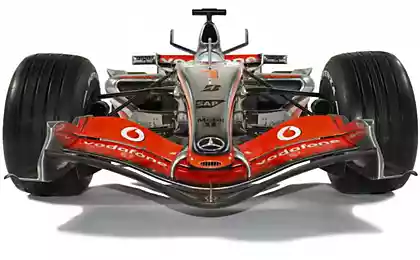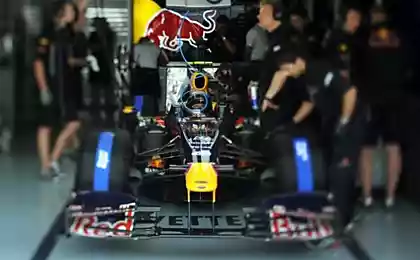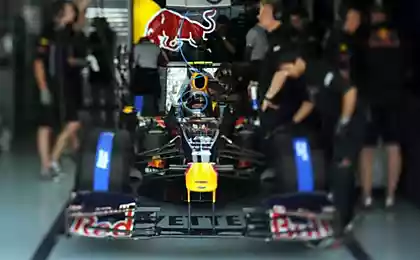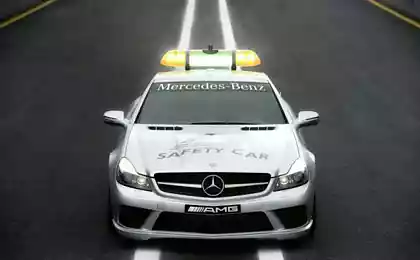582
Steering wheel Formula 1 car
Everyone knows that in modern Formula 1 car steering wheel many different buttons and switches. But why so many? Let's try to understand you.
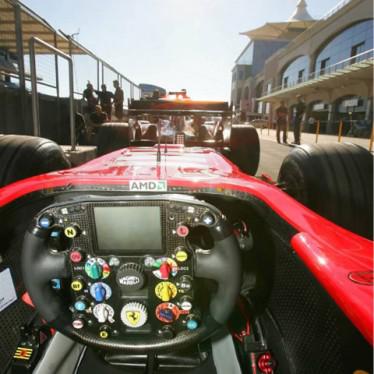
History
Just in 1992 near the steering wheel in the Formula 1 car is nothing special. Usually circular piece with a metal plate in the middle for the attachment to the steering column, and not more than three buttons - one of them to select the neutral gear, the second for drinking the liquid through the tube into the pilot's helmet, and the third well to radio communications.
The development of complex electronic systems in the 90 years has completely changed the idea of the handlebars. Team McLaren engineer John Barnard was the first to introduce a revolutionary system that allowed Nigel Mansell shift gears without taking your hands off the wheel. On the back of the steering levers appeared; pushing yourself to the left lobe of the lever could turn down the transmission, and the right - up respectively. Switching the transmission thus virtually ruled pilot error in the choice of an incorrect transmission, and, of course, improves the smooth shifting, which directly leads to a reduction in delays in transmission. This innovation, along with the emergence of semi-automatic gearboxes, it was the most significant event for the pilots for a fairly long period of time in the history of Formula 1. A little later, with the emergence of the practice of left-foot braking, removed the clutch pedal; very well become completely automatic clutch and hydraulic clutch operation synchronized with the gear change on the steering wheel.
The algorithms of the engine, traction control, auxiliary systems to optimize at startup - all require the presence of additional buttons and switches to allow the pilot to more flexibly manage the car on the track. Modern Formula 1 steering wheels are also equipped with an additional lever and clutch, which pilots can use during ostavnovki, for example, or a pitstop in the gravel trap at the departure from the track, thus not allowing the engine to stall.
Design features
At present, the wheel is a complex electronic device that allows the pilot to change a huge amount of settings. Very often, the Formula 1 team appoint a special engineer who is responsible for the electronics and steering comfort. Using a type of hard rubber and anatomical shape helps the pilot to reliably hold the steering wheel in his hands. Frame steering as many other parts of the car of Formula 1, made of a carbon fiber (carbon fibre) to reduce its weight. Cost per unit steering - € about 23, 000, and this price is very easy to explain - approximately 100 hours spent on its production using the above materials, as well as aluminum, titanium, steel and plastic.
Most carry a rudder control 12 different parameters of the car, so do not be surprised that when you build using up to 120 different components - buttons, switches, etc. And despite the abundance of materials and parts, wheel weighs only 1, 3 kg.
For one season of Formula 1 for each of the pilots assigned to at least 5 rudders - for races 3 and 2 tests. Do not forget about the test pilots, they are still owed for every 2 helm. Despite the high cost of the steering wheel, some teams prefer not to leave the wheel of the winning car, and immediately add it to his collection in memory of the win the Grand Prix.
FIA Regulations requires the existence of a special mechanism (spring-loaded ring with the back of the steering wheel) for easy removal of the steering wheel.
Handlebar BMW Sauber in 2006:
1. The speed limit in the pitlane
2. Increase the differential
3. Increase the engine speed
4. Transfer up
5. Increased traction control
6. Mode switch engine load
7. Clutch lever
8. Traction control
9. Communication with the team while on the pitlane.
10. Lock traction control
11. Multifunction switch
12. Change topplivnoy mixture
13. Diagnostics
14. Information before the pitstop the team the necessary settings aerodynamic elements
15. Clutch
16. Mode switch differential
17. The radio
18. Reduction of traction control
19. Passing down
20. Reduction of engine speed
21. Reduction of differential
22. Neutral gear
23. The mode selection menu display.
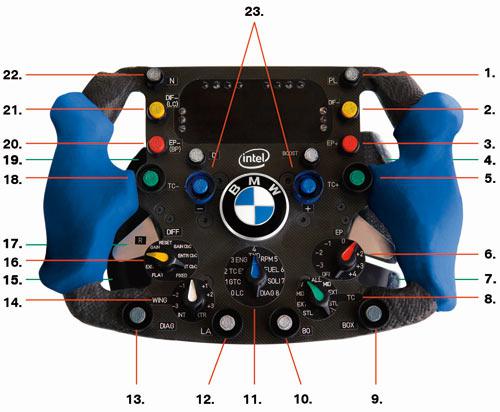
Handlebar BMW Sauber 2007.
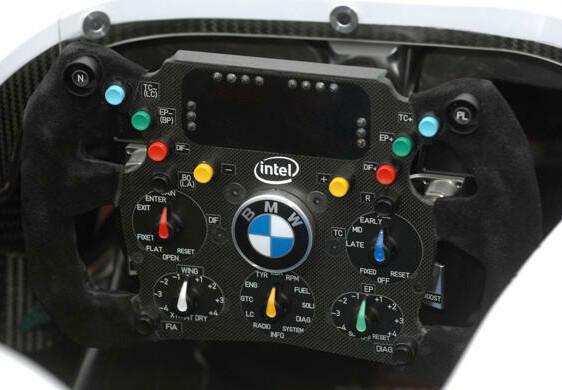
Source:

History
Just in 1992 near the steering wheel in the Formula 1 car is nothing special. Usually circular piece with a metal plate in the middle for the attachment to the steering column, and not more than three buttons - one of them to select the neutral gear, the second for drinking the liquid through the tube into the pilot's helmet, and the third well to radio communications.
The development of complex electronic systems in the 90 years has completely changed the idea of the handlebars. Team McLaren engineer John Barnard was the first to introduce a revolutionary system that allowed Nigel Mansell shift gears without taking your hands off the wheel. On the back of the steering levers appeared; pushing yourself to the left lobe of the lever could turn down the transmission, and the right - up respectively. Switching the transmission thus virtually ruled pilot error in the choice of an incorrect transmission, and, of course, improves the smooth shifting, which directly leads to a reduction in delays in transmission. This innovation, along with the emergence of semi-automatic gearboxes, it was the most significant event for the pilots for a fairly long period of time in the history of Formula 1. A little later, with the emergence of the practice of left-foot braking, removed the clutch pedal; very well become completely automatic clutch and hydraulic clutch operation synchronized with the gear change on the steering wheel.
The algorithms of the engine, traction control, auxiliary systems to optimize at startup - all require the presence of additional buttons and switches to allow the pilot to more flexibly manage the car on the track. Modern Formula 1 steering wheels are also equipped with an additional lever and clutch, which pilots can use during ostavnovki, for example, or a pitstop in the gravel trap at the departure from the track, thus not allowing the engine to stall.
Design features
At present, the wheel is a complex electronic device that allows the pilot to change a huge amount of settings. Very often, the Formula 1 team appoint a special engineer who is responsible for the electronics and steering comfort. Using a type of hard rubber and anatomical shape helps the pilot to reliably hold the steering wheel in his hands. Frame steering as many other parts of the car of Formula 1, made of a carbon fiber (carbon fibre) to reduce its weight. Cost per unit steering - € about 23, 000, and this price is very easy to explain - approximately 100 hours spent on its production using the above materials, as well as aluminum, titanium, steel and plastic.
Most carry a rudder control 12 different parameters of the car, so do not be surprised that when you build using up to 120 different components - buttons, switches, etc. And despite the abundance of materials and parts, wheel weighs only 1, 3 kg.
For one season of Formula 1 for each of the pilots assigned to at least 5 rudders - for races 3 and 2 tests. Do not forget about the test pilots, they are still owed for every 2 helm. Despite the high cost of the steering wheel, some teams prefer not to leave the wheel of the winning car, and immediately add it to his collection in memory of the win the Grand Prix.
FIA Regulations requires the existence of a special mechanism (spring-loaded ring with the back of the steering wheel) for easy removal of the steering wheel.
Handlebar BMW Sauber in 2006:
1. The speed limit in the pitlane
2. Increase the differential
3. Increase the engine speed
4. Transfer up
5. Increased traction control
6. Mode switch engine load
7. Clutch lever
8. Traction control
9. Communication with the team while on the pitlane.
10. Lock traction control
11. Multifunction switch
12. Change topplivnoy mixture
13. Diagnostics
14. Information before the pitstop the team the necessary settings aerodynamic elements
15. Clutch
16. Mode switch differential
17. The radio
18. Reduction of traction control
19. Passing down
20. Reduction of engine speed
21. Reduction of differential
22. Neutral gear
23. The mode selection menu display.

Handlebar BMW Sauber 2007.

Source:






